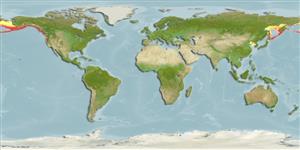Actinopterygii (ray-finned fishes) >
Scorpaeniformes (Scorpionfishes and flatheads) >
Cottidae (Sculpins)
Etymology: Hemilepidotus: Greek, hemi = half + Greek, lepis = scale + Greek, ous, otis = ear (Ref. 45335).
Environment / Climate / Range
Ecology
Marine; demersal; depth range 0 - 450 m (Ref. 58496). Temperate, preferred ?; 66°N - 34°N
North Pacific: Kamchatka, Russia and along the Commander and Aleutian Islands to St. Paul Island in the Bering Sea and to Monterey Bay, California, USA.
Size / Weight / Age
Maturity: Lm ? range ? - ? cm
Max length : 51.0 cm TL male/unsexed; (Ref. 2850); max. published weight: 1.1 kg (Ref. 40637)
Dorsal
spines
(total): 10 - 12;
Dorsal
soft rays
(total): 18-20;
Anal
spines: 0;
Anal
soft rays: 13 - 16;
Vertebrae: 35. Dorsal with moderate notches in the spinous part after the third spine, and between the spinous and rayed parts; caudal bluntly rounded; pelvic fins larger in males (Ref. 6885). Color variable, predominately red, sometimes brilliant red, with brown, white, and black mottling and spotting all over; there are four irregular dark saddles across back; the caudal fin with darker rays, sometimes with vertical light bars; some large males with darkly spotted pelvic fins (including base of pectorals) (Ref. 6885).
Usually near shore in rocky areas (Ref. 2850), from intertidal areas to 275 m depth (Ref. 6793). Adults feed on crabs, barnacles, and mussels (Ref. 6885). Good eating (Ref. 2850).
Life cycle and mating behavior
Maturity | Reproduction | Spawning | Eggs | Fecundity | Larvae
Eschmeyer, W.N., E.S. Herald and H. Hammann, 1983. A field guide to Pacific coast fishes of North America. Boston (MA, USA): Houghton Mifflin Company. xii+336 p. (Ref. 2850)
IUCN Red List Status (Ref. 115185)
CITES (Ref. 94142)
Not Evaluated
Threat to humans
Harmless
Human uses
Fisheries: commercial; gamefish: yes; aquarium: public aquariums
More information
ReferencesAquacultureAquaculture profileStrainsGeneticsAllele frequenciesHeritabilityDiseasesProcessingMass conversion
Tools
Special reports
Download XML
Internet sources
